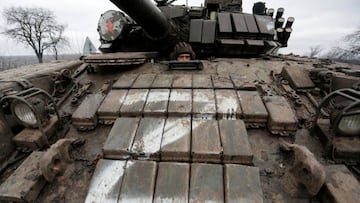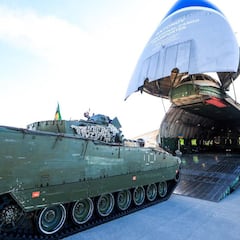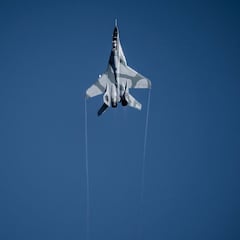Theories about the mysterious 'Z' on Russian tanks in Ukraine
Russian military vehicles advancing into Ukrainian territory have different symbols drawn on their bodywork, although 'Z' is the most commonly used.


Russian tanks, artillery and military vehicles that have been crossing Ukraine's borders for days now are adorned with a series of symbols drawn in white paint. These symbols range from letters to geometric figures and even combinations of the two. In fact, more than ten different combinations have been seen on the bodies, both front and sides, of these war vehicles. But what do they mean?
More news and insight on Russia-Ukraine conflict:
- Anonymous hack Russian TV
- Donald Trump jokes about bombing Russia with China-flagged planes
- Nuclear arsenals around the world
- American veterans fighting Russia in Ukraine
- Vladimir Putin lookalike: the innocent man scared for his life
‘Z tanks’ explained
From all the footage that has been observed to date, it would appear that the most commonly seen is the letter ‘Z’, framed within either a square, rectangle or triangle. One theory put forward as to why these symbols are painted on the vehicles is that they can reduce the chances of being hit by friendly fire. For example, both the Russian and Ukrainian forces use the same model of tank, and so they use this personalised symbology to distinguish themselves from the enemy.
Another reason, however, is that they may pertain to the locations where the units are stationed. Michael Clarke, former director of the defence think tank RUSI, explained this idea to Sky News.
"Often these symbols will be location-based: they will communicate where the unit is going," he said, pointing to the various designs seen in recent days. "These are probably symbols that say which units are heading northeast or northwest in a region, for example.”
Looks like another abandoned and damaged Russian military column in the Izyumsky district, Kharkiv Oblast. Mostly fuel trucks. Russian forces appear to be doing a poor job of defending their supply lines. https://t.co/DB1vcISCM0 pic.twitter.com/hJO1wfhbnB
— Rob Lee (@RALee85) February 28, 2022
This suggest that if they only wanted to communicate that they are Russians, there would not be the different symbols that we have witnessed, just the one required. And Clarke also stated that this is normal practice in battles, citing the example of the United States using chevrons to identify different units in Iraq.
Military symbols have limited shelf life
Another hypothesis regarding the paint markings relates to the specific mission of each vehicle.
"Most Z markings seen so far have been inside a square, but this Ural truck with an Msta-B howitzer has one inside a triangle," Rob Lee, a PhD student and observer of Russian defence policy, wrote on Twitter.
"Possibly indicating different working groups within a formation," he concluded.
TOS-1A thermobaric MLRS and T-72B tanks with roof screens in northern Crimea heading north from yesterday. https://t.co/myb91I73p4https://t.co/5Q9eXJEK6L pic.twitter.com/xh7cxjhsln
— Rob Lee (@RALee85) February 25, 2022
However, an important factor has been raised about how these markings drawn on military vehicles lose their effectiveness as the days go by. As enemy intelligence picks up patterns, especially with high-spec modern surveillance tools, these symbols could work against the occupants, potentially giving clues to the tactics being deployed.
Analysing the military might of Russia
By all accounts, and recent statements about nuclear capabilities, President Vladimir Putin did not expect such a difficult time taking Ukraine, especially given the vast difference between their military forces. NATO has edged its own substantial might to its eastern-most members that neighbour the conflict, but have said they will not join the war directly, instead providing support for Ukraine.
It's worth noting that, after Russia, the next four largest military forces in Europe are members of NATO. The combined strength of the 30-member alliance, which includes two thirds of the European nations along with the huge strength of the United States, surpasses that of Russia in some areas but in others is on a par. Let's look at the numbers.
Which are the largest militaries in Europe?
Prior to the end of the Cold War Western European nations spent on average 2.4 percent of GDP on the military. However, by 2020 that had dropped to just 1.6 percent of GDP but the reduction in the size of each nation’s armed forces was unequal.
Germany, then just the western portion, on the front line of the Iron Curtain had the largest standing army followed by Italy, France and Britain. The picture has changed a bit since then with France possessing the largest European military force, after Russia, followed by the UK, Italy and Germany, respectively.
#NATO Allies are boosting their political and practical support to #Ukraine as it continues to defend itself against Russia’s full-scale invasion#StandWithUkraine🇺🇦
— NATO (@NATO) February 27, 2022
The downsizing of military spending occurred in Russia as well. However, around 2009 spending picked up again according to the Stockholm International Peace Research Institute (SIPRI) data.
How big are the standing armies in Europe?
As a single nation Russia has the largest force of a European nation with 850,000 active personnel, or ready to deploy. They have another half million that they could call upon on short notice.
However, Russia doesn't have the most troops in the world, that title goes to China. However, Russia must also protect a vast area covering around a tenth of the Earth’s land.
Ukraine has a sizeable force with 200,000 active personnel and 500,000 when reservists and paramilitary forces are included. In the current conflict the nation has called on all males 18 to 60 years old to take up arms. As well, they have handed out weapons to all citizens that wish to pitch in along with instructing the population how to make Molotov cocktails.
This was the world’s largest aircraft, AN-225 ‘Mriya’ (‘Dream’ in Ukrainian). Russia may have destroyed our ‘Mriya’. But they will never be able to destroy our dream of a strong, free and democratic European state. We shall prevail! pic.twitter.com/TdnBFlj3N8
— Dmytro Kuleba (@DmytroKuleba) February 27, 2022
For comparison according to Global Firepower, France has 205,000 active personnel, the UK 194,000, Italy 170,000 and Germany 184,000. However, the combined number of troops that NATO can call on is close to 3.4 million with another 2 million reservists and paramilitary forces according to Statista.
Russia and NATO: heavy armour
Although NATO has almost four times the number of ready to deploy troops as Russia, there is less of a gap in heavy weapons. NATO combined has around 2,300 more tanks than Russia. Nearly half of the alliance’s 14,682 tanks come from the US. Where Russia has its greatest advantage is in artillery which between stationary and mobile units including rocket launchers numbers around 17,500.
Although they haven’t brought all their tanks and heavy equipment to Ukraine, its been estimated that roughly half the firepower Russia has was amassed along the border prior to invasion. They’ll encounter around 2,600 tanks, around 3,100 artillery fixed and mobile in addition to 490 rocket launchers in Ukraine.
This is unbelievable - people stealing Russian tanks 😂#Ukraine #Anonymous pic.twitter.com/s3726szWTP
— Anonymous Europe (@AnonEUforUKR) February 28, 2022
Air superiority is key in modern day warfare
Related stories
Controlling the skies is critical to battlefield victory. Air superiority allows an army to be more maneuverable and to concentrate its forces. Individually the four biggest Western European air forces don’t come close to Russia’s 772 fighter jets, but NATO has a combined force of over 3,500 fighter jets.
Even just the four top European NATO members have a combined 611 fighter jets they can scramble.

